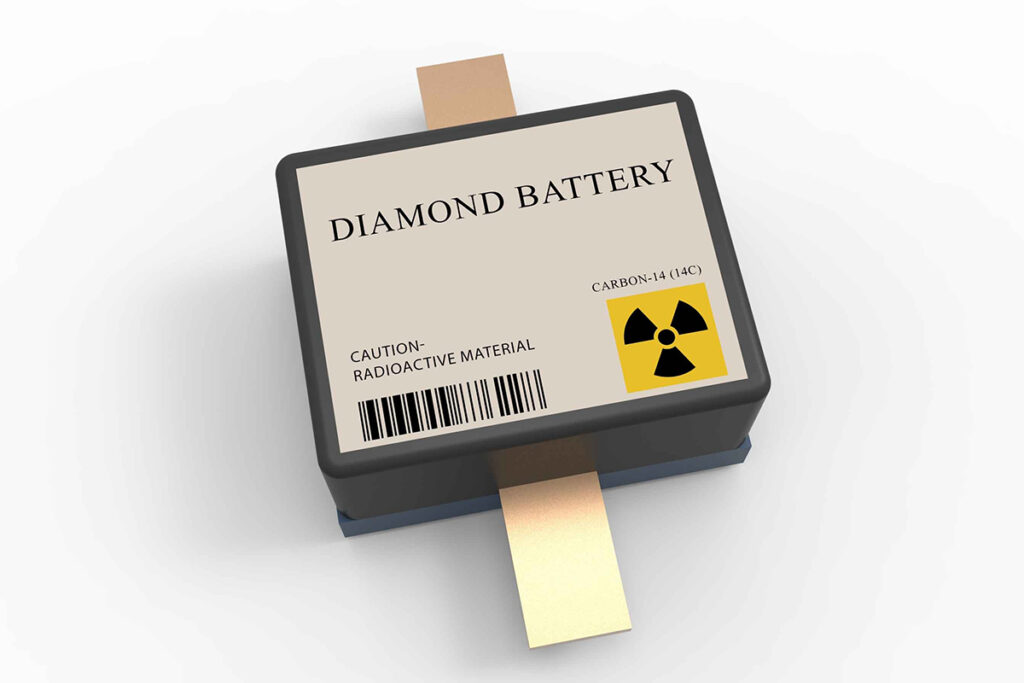The emergence of carbon-14 diamond batteries marks a transformative milestone in energy technology. Unlike conventional lithium-ion batteries, this innovative solution offers an unparalleled lifespan, capable of delivering power for thousands of years. By leveraging the natural decay of carbon-14, a radioactive isotope, these batteries promise durability, sustainability, and a broad spectrum of applications.
The Science Behind Carbon-14 Diamond Batteries
At the core of this breakthrough lies an elegantly simple mechanism. Carbon-14 undergoes radioactive decay, transforming into nitrogen-14 and releasing beta radiation as high-energy electrons. Encased in a synthetic diamond structure, this radiation is captured and converted into a continuous electrical current. The energy is transmitted to connected devices through external wires, providing a consistent and dependable power supply.
This unique design not only guarantees exceptional durability but also boasts impressive resilience. With a half-life of 5,700 years, carbon-14 outlasts traditional power sources by several orders of magnitude. Such longevity makes these batteries ideal for applications where replacement is impractical or impossible.
Diverse Applications of Diamond Batteries
Carbon-14 diamond batteries have the potential to revolutionize multiple industries. In healthcare, they could power devices like pacemakers for an entire lifetime, eliminating the need for frequent surgical battery replacements. Similarly, remote sensors in extreme environments, such as undersea monitoring systems or volcano detectors, could function seamlessly for centuries without human intervention.
Space exploration stands to gain significantly from this technology. Current radioisotope thermoelectric generators (RTGs) rely on converting radioactive decay heat into electricity, making them bulky and less efficient. Carbon-14 batteries, however, produce electricity directly, reducing spacecraft weight and increasing efficiency. This innovation could enable extended space missions and enhance humanity’s exploration capabilities.
Addressing Challenges in Commercialization
Despite their vast potential, bringing carbon-14 diamond batteries to market involves significant hurdles. The energy generated by carbon-14 decay is relatively low, requiring innovative designs to achieve practical power outputs. Furthermore, sourcing and refining carbon-14 from nuclear waste is both complex and resource-intensive.
Nonetheless, advancements continue to be made. Early prototypes demonstrate the feasibility of this technology on a small scale, while parallel developments in related technologies, such as nickel-63 diamond batteries, highlight the growing interest in radioisotope-powered energy solutions.
Shaping a Resilient Energy Future
The impact of carbon-14 diamond batteries extends far beyond their extraordinary lifespan. They represent a step toward more robust and sustainable energy systems, especially for critical applications like medical devices, remote monitoring, and space exploration. By providing uninterrupted power for centuries, these batteries have the potential to redefine how essential devices are powered.
As researchers refine the technology and overcome production challenges, carbon-14 diamond batteries may become a cornerstone of next-generation energy solutions. Their ability to deliver long-lasting, reliable power could revolutionize industries and open new frontiers, offering a glimpse into a sustainable energy future.


